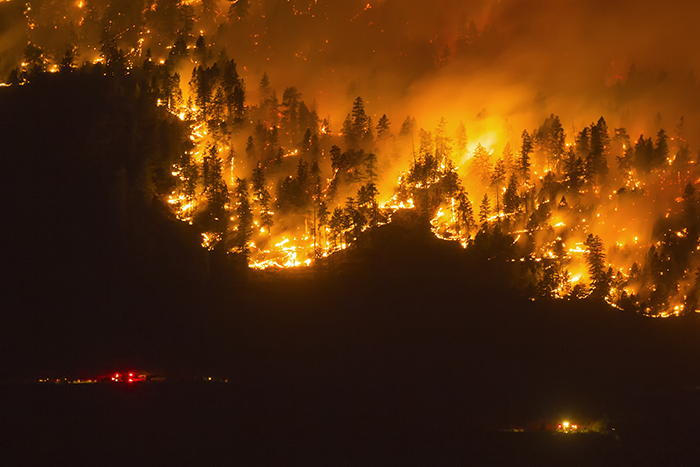Interviews / Global Health Observatory
22 May 2024
Boreal Forest Fires: Still Overlooked Impacts on Global Climate and Health

As the Northern Hemisphere heads into summer, wildfire season has already begun. In Canada, the first flames appeared on 20 February 2024 in the province of Alberta. In Russia, by mid-March, Siberia had already seen eight blazes. In what way are these fires a global health issue, accelerating climate change? An update with Dr Anne Sénéquier, researcher at IRIS in charge of the Global Health Observatory.
Why is wildfire risk not just a problem for northern countries?
The boreal forest or taiga is the second largest forest biome in the world, stretching mainly across the northern regions of the Northern Hemisphere.
With the global warming of the climate system, polar regions are warming faster. The reduction of snow cover and the extent of sea ice increasingly exposes land and marine surfaces, which are characterised by lower reflectivity (lower albedo) and therefore greater absorption of solar radiation. This process increases local warming, thereby fuelling a vicious cycle that threatens the permafrost.
This frozen soil, which covers a quarter of the landmass in the Northern Hemisphere, contains vast quantities of carbon. In 2014[1], a study estimated the amount of carbon in the permafrost at 6,233,390 million tonnes of CO₂, or 2.88 times more than the current amount of CO₂ in the atmosphere—making permafrost a veritable weapon of mass destruction for our climate. Higher-than-normal temperatures in the Arctic Circle, coupled with decades of human maladaptation, are encouraging the outbreak of fires.
In 2024, some wildfires are still not accounted for in annual greenhouse gas emission inventories. Yet emissions from these fires were estimated[2] at 10 to 15% of global emissions in 2019 and 2020. In 2023, wildfires in Canada’s boreal forest released three times more CO₂ than the country’s annual emissions. Wildfires are likely to pose a serious challenge to the Paris Agreement.
Several reasons explain this astronomical quantity of carbon in Arctic soil.
First, geography: as the last ice age ended, the retreating glaciers left behind an almost aquatic landscape. Canada today contains over 2 million lakes, Russia 2.8 million, and Scandinavia 730,000—around which flourish numerous wetlands made up of peat bogs. A peat bog is an organic soil formed by the incomplete degradation of accumulated vegetation in water-saturated conditions.
A layering of vegetation extending over more than a millennium thus releases several generations’ worth of carbon when burned, which explains the dramatic CO₂ emissions of a peat fire—10 to 100 times greater than those of a surface wildfire. A peat fire has the particularity of burning the surface vegetation cover, but it can also go underground and become what is known as a “zombie fire”. It then remains invisible, only to resurface the following spring… not without having promoted the thawing of the permafrost it sat beneath all winter.
Moreover, the boreal forest is mostly composed of conifers. These include spruces, pines, and Siberian larches, whose needles contain compounds such as lignin that are more resistant to decomposition once on the ground. This slow decomposition leads to an accumulation on the forest floor, resulting in a greater carbon storage capacity in the soil, making the boreal forest a key asset in the fight against climate change. Furthermore, this spruce litter—composed of needles and organic matter resistant to decomposition—creates an insulating layer on the soil’s surface that protects the permafrost from rapid warming during the hottest months.
However, the increasing frequency of fires in the boreal forest—whether in Canada, Scandinavia or Siberia—endangers the regeneration of conifer forests. Historically, boreal forests burn once a century, allowing the ecosystem to renew itself and giving the forest ample time to regenerate. A fire cycle that is too rapid prevents conifers from keeping pace with this natural rhythm, giving way to deciduous trees that adapt more quickly to these frequently disturbed conditions. A new breach that could fuel the vicious circle of warming in the boreal forest.
Additionally, with a less dense canopy, deciduous trees offer less protection to the soil from solar radiation—just as their leaves, which decompose easily, offer less protection to the soil… and thus to the permafrost.
In 2023, Canada’s wildfires shattered records by burning over 16.5 million hectares of forest (compared to an annual average of 2.5 million hectares). Low population density and the remoteness of major urban centres have encouraged a laissez-faire policy for several decades. A policy now being questioned in light of the dual impact of these mega-fires: their impact on climate change, but also on health issues.
How do wildfires affect our health and future?
On 6 June 2023, 11 million people in New York City and its surrounding areas found themselves trapped in smoke from wildfires raging 900 km further north. Smoke that reached France three weeks later, after a transatlantic journey in the upper troposphere.
This smoke is a mixture of soot, CO, and dozens of other particles. The main issue remains its concentration in fine particulate matter (PM2.5), due to its ability to cross the alveolar-capillary barrier. This characteristic enables the particles to enter the bloodstream and thereby reach every organ[3].
Once in the bloodstream, PM2.5 particles are perceived as infectious agents. This triggers an immune response, which can have repercussions on the cardiovascular system, while bronchial inflammation makes breathing more difficult.
These smoke particles are additional risk factors that impact infectious diseases such as flu and/or COVID-19, particularly in the most vulnerable populations. In 2020, increased levels of fine particulate matter in the states of California, Washington and Oregon were associated with 19,700 additional COVID-19 cases and 750 deaths. On the other side of the Pacific, Australia’s 2019 mega-fires caused 1,305 hospital admissions for asthma attacks, 3,151 for cardio-respiratory problems, and an estimated excess mortality of 417 deaths. Between 2007 and 2012 in California, 7,000 premature births were attributed to wildfire exposure during pregnancy. More broadly, an analysis[4] of over 65 million deaths in 43 countries revealed an increased risk of all-cause mortality shortly after exposure to fine particles from wildfires.
And we should expect a growing impact of wildfire consequences on global health in the years to come. By 2054, smoke from wildfires is expected to impact New York City for an average of 8 days per year, rendering the air unhealthy (compared to 2 days currently). Los Angeles County is expected to experience 54 days of unhealthy air for sensitive groups, 90 days for Fresno County, California, including three weeks labelled as “dangerous”. Fresno is the largest city (half a million residents) in California’s Central Valley, where smoke and pollution accumulate between mountains without any outlet.
The long-term effects will likely be even more harmful for children, due to their young age at the time of exposure.
The additional health concern unique to boreal wildfires stems from the thawing of permafrost, which contains, beyond CO₂, a multitude of infectious agents to which we are no longer—or never were—immune. The effect could be as devastating as the encounter between Indigenous populations and smallpox in the 16th century…
In 2016, the thawing of permafrost, for instance, released the carcass of a reindeer infected with anthrax in Siberia. The spread of spores led to a cluster of cases resulting in the death of hundreds of reindeer and a young boy. In 2014, two giant viruses were successfully reactivated by a team of French microbiologists after lying dormant in the ice for 30,000 years.
We are therefore facing a growing risk—especially when taking into account the increasing population in these boreal zones, particularly due to the establishment of mining infrastructure in Siberia (open-pit mines, gas extraction, the Northern Sea Route…) which are further opening the door to the Pandora’s box that is permafrost.
[1] Schuur, Edward A. G., Benjamin W. Abbott, William B. Bowden, Victor Brovkin, Philip Camill, Josep G. Canadell, Jeffrey P. Chanton, et al. « Expert Assessment Of Vulnerability Of Permafrost Carbon To Climate Change ». Climatic Change 119, no 2 (26 mars 2013) : 359‑74. https://doi.org/10.1007/s10584-013-0730-7.7
[2] Guo, M., Li, J., Wen, L., and Huang, S. (2019). Estimation of CO2 emissions from wildfires using OCO-2 data. Atmosphere 10, 581. doi: 10.3390/atmos10100581
[3] Kozlov, Max. « How Record Wildfires Are Harming Human Health ». Nature 599, no 7886 (24 novembre 2021) : 550‑52. https://doi.org/10.1038/d41586-021-03496-1.
[4] Ibid.

